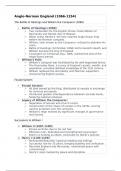Samenvatting
Summary Anglo-Norman England ()
- Vak
- Instelling
This course, titled "Anglo-Norman England ()," delves into a pivotal period in English history marked by the Norman Conquest and the subsequent establishment of a new political and social order. The primary focus is on the Battle of Hastings in 1066, where Duke William of Normandy and Harold, Earl ...
[Meer zien]



